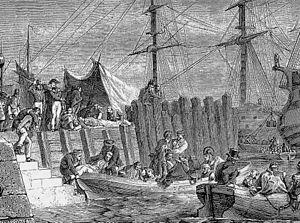
Back حملة فالشيرين Arabic Tro-vrezel Walcheren Breton Walcheren-Expedition German Kampanjo Walcheren Esperanto Expedición Walcheren Spanish Expédition de Walcheren French Walchereni hadjárat Hungarian Kampanye militer Walcheren ID Spedizione di Walcheren Italian Walcherenexpeditie Dutch
| Walcheren Campaign | |||||||
|---|---|---|---|---|---|---|---|
| Part of the War of the Fifth Coalition | |||||||
 Illness-stricken British troops evacuating the island of Walcheren on 30 August. | |||||||
| |||||||
| Belligerents | |||||||
|
|
| ||||||
| Commanders and leaders | |||||||
|
|
| ||||||
| Strength | |||||||
|
July: 20,000 August: 46,000 |
39,000 616 ships | ||||||
| Casualties and losses | |||||||
|
4,000 dead, wounded or captured (including 1st battalion, Irish legion) 5,000+ sick |
4,150 dead, wounded or captured 12,000+ sick | ||||||
Walcheren Campaign
The Walcheren Campaign ([ˈʋɑlxərə(n)] WAHL-khə-rən) was an unsuccessful British expedition to the Netherlands in 1809 intended to open another front in the Austrian Empire's struggle with France during the War of the Fifth Coalition. Sir John Pitt, 2nd Earl of Chatham, was the commander of the expedition, with the missions of capturing Flushing and Antwerp in the Netherlands and enabling navigation of the Scheldt River. Some 39,000 soldiers and 15,000 horses, together with field artillery and two siege trains, crossed the North Sea and landed at Walcheren on 30 July. This was the largest British expedition of that year, larger than the army serving in the Peninsular War in Portugal. Nevertheless, it failed to achieve any of its goals. The Walcheren Campaign involved little fighting, but heavy losses from the sickness popularly dubbed "Walcheren Fever". Although more than 4,000 British troops died during the expedition, only 106 died in combat; the survivors withdrew on 9 December.[1]
- ^ Brett-James 1963, pp. 811–820.
© MMXXIII Rich X Search. We shall prevail. All rights reserved. Rich X Search
